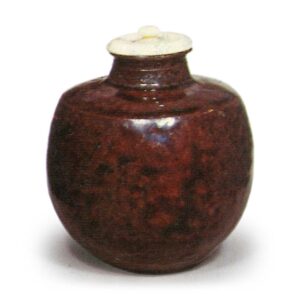
A great masterpiece. A tea caddy with a Chinese design of Bunrin. Also called Mikazuki Bunrin. It is also called Honnoji Bunrin because Oda Nobunaga donated it to Honnoji Temple, and Asakura Bunrin because it once belonged to Asakura Yoshikage. The origin of the name “Crescent Moon Bunrin” is unknown. The mouth is tight, the rounded edge is shallowly twisted, and the steamer is tight in the middle (the lower part is stretched, and there is a very thin floating line in the middle of the steamer and the steamer’s edge, which is not seen in other steppers). The body is small and the bottom is small, giving the impression of a beautiful woman. The overall color is black candy brown, the workmanship is slender and exquisite, and the two candy-colored streams fall down from both sides and stop at the edge of the tray.
The scene is beautiful, and the luster is so brilliant that it cannot be described in words. The entire body is glazed, and only a small amount of vermilion clay is visible around the outer edge of the itokiri. The fine and delicate cut of the thread is incomparable, and the shape and workmanship are all feminine and gracefully elegant. Originally owned by Asakura Yoshikage, this tea caddy was owned by Oda Nobunaga, Nakai Yamatomori of Honnoji Temple in Kyoto, and Kobori Niemon before joining Matsudaira Fumai. (Gankan Meimono Ki, Komeimono Ki, Kokin Meimono Ruiju, Seto Toki Rabinokuchi, Taisho Meikikan, etc.)



